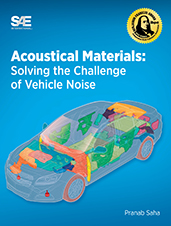Technical Paper
A Correlation between Oberst Bar and Center Point Damping Results
2009-05-19
2009-01-2134
The SAE International standard for testing Oberst bars has been used in the industry for many years with predictable results. Growing interest in testing wider samples to incorporate more of the variability in liquid applied sprayable dampers has led to increased use of a center point damping test method based on a Japanese standard JIS G 0602. This method is similar to that of the ISO 16940 standard for testing laminated glass. Theory shows us that an Oberst test with a free length equal to the half length of a bar used for center point testing will provide the same resonances. This paper intends to show a relationship between the resonances of bars tested with the Oberst and center point test methods. A correlation between the composite loss factor for samples tested with each of the methods will be illustrated.

